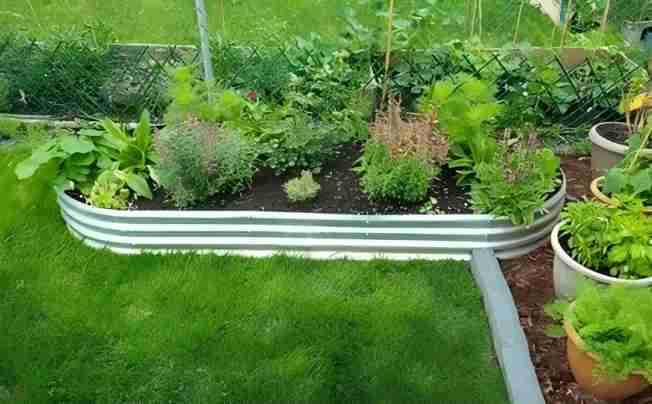Are Galvanized Containers Safe For Gardening?
In the field of modern gardening, galvanized containers are widely used in many scenarios due to their unique advantages.
Safety Analysis: Potential Risks
Zinc dissolution risk
Higher concentrations of highly active hydrogen ions are seen in acidic soil. It will be simpler for zinc to dissolve into the soil solution as ions as a result of their chemical reaction with the zinc layer on the galvanised container's surface.
Another significant element influencing zinc solubility is water. Long-term moisture retention in the soil allows water to stay in touch with the galvanised container, creating ideal conditions for the dissolution of zinc. The soil surrounding the galvanised container has a high moisture content in some places with a lot of rain or excessive watering, which raises the possibility of zinc breakdown. Conversely, the dissolution rate of zinc will be considerably slowed down in a dry soil environment because the absence of water hinders the transfer of zinc ions.
Impacts on the growth of plants
Plants that take too much zinc will suffer numerous unfavourable effects on their growth, development, and physiological processes. According to research, too much zinc can prevent plant root cells from dividing and lengthening, which results in sparse, short roots that are unable to efficiently absorb water and nutrients from the soil. This stunts the growth of the plant's aboveground portions, making the plants slender and short.
In terms of physiological function, too much zinc can disrupt plant enzyme functioning. Numerous enzymes are essential to plant metabolism. For instance, too much zinc might prevent plants' nitrate reductase, a crucial enzyme for nitrogen metabolism, from functioning. Its activity is suppressed, which can cause problems for plants to absorb and use nitrogen. This can subsequently impact the production of plant proteins, resulting in slower plant growth and yellowing leaves. Auxin production and transport in plants can also be impacted by excessive zinc. Plant growth and development are significantly regulated by auxin. Plant growth abnormalities and leaf curling can result from disruptions in its synthesis and transportation.

Safety Analysis: Favorable Factors
supplies necessary trace elements
Zinc is essential for plant metabolism and is involved in the creation of several different enzymes in plants. Zinc is a crucial component of carbonic anhydrase, an enzyme that is essential to plant photosynthesis. Similar to providing enough raw materials for factory production, carbonic anhydrase can facilitate the release of carbon dioxide during photosynthesis and speed up its entry into chloroplasts through lipid membranes. This allows ribulose diphosphate carboxylase to use the carbon dioxide as a substrate, which facilitates the smooth progression of photosynthesis.
Additionally, zinc can encourage the production of plant auxin. Auxin production is inhibited in zinc-deficient plants, which leads to short and sluggish plant growth. The proper amount of zinc can maintain healthy plant growth and guarantee the regular synthesis of plant auxin. To satisfy the plant's need for zinc, encourage crop growth and development, and raise crop output and quality, some farmers will fertilise the soil with a suitable quantity of zinc fertiliser.
Chemical characteristics that are comparatively stable
Galvanised containers' chemical characteristics are comparatively constant in typical horticultural settings, offering a strong assurance of their safe horticultural application. The zinc coating on the surface of the galvanised container can remain rather stable within the usual pH range of soil, which is between 6.5 and 7.5. It will not readily react chemically with soil materials to release a significant amount of zinc ions. Because of the extremely low and nearly insignificant amount of zinc dissolved in the galvanised container in neutral soil, plants growing there are not harmed by too much zinc.
The galvanised container can remain stable even when exposed to external conditions that include wind, sun, and temperature fluctuations. In addition to efficiently shielding the internal steel from moisture and oxygen, the zinc layer can also stop some chemicals from eroding. Although there may be some acidic gases in the air in places with high levels of industrial pollution, the galvanised container can withstand these conditions and won't quickly release a lot of zinc ions when it comes into contact with them, protecting the environment in which plants grow.

Usage suggestions and precautions
1. Select the appropriate container
Take note of the zinc layer's thickness first. A thicker zinc coating on high-quality galvanised containers can offer longer-lasting anti-rust protection and lower the chance of zinc breakdown. The thickness of the zinc layer can be measured with a professional zinc coating thickness gauge. In general, galvanised containers that have a zinc layer between 80 and 100 microns thick are the best and can continue to function well in a horticultural setting.
High-quality steel is the ideal substrate for galvanised containers since it has a direct impact on the container's strength and longevity. Certain lower-quality steels may have more impurities, making them more prone to rust and breaking while in use, which could compromise plant growth and container safety. When picking, you can read the container's product description to learn about its material details or speak with the seller to make sure the chosen container's material satisfies the specifications.
2. Selection of plants and soil
When choosing a soil, try to stay away from utilising one that is excessively acidic. Because acidic soil hinders plant growth and raises the possibility of zinc solubility. The pH range of 6.5 to 7.5 is the optimal range for soil. The zinc coating on the galvanised container's surface can remain comparatively stable and zinc dissolution can be minimised in a soil environment that is nearly neutral. By adding alkaline materials like lime, the pH of extremely acidic soil can be brought within a suitable range.
Certain plants with high zinc tolerance are better options when it comes to plant variety selection. Sunflowers, for instance, may grow healthily even in soil that contains a specific quantity of zinc because they have a comparatively high tolerance to the metal. Mint and basil are two examples of herbaceous plants that can be grown in galvanised containers since they have a strong tolerance to zinc. Certain plants that are more sensitive to zinc, like blueberries, may be impacted by too much zinc when planted in galvanised containers, which could lead to poor growth and make them unsuitable for selection because they require an acidic soil environment to grow and have a low tolerance to zinc.
3. Upkeep and observation
Regular monitoring and maintenance are necessary to guarantee the efficacy and safety of galvanised containers in horticultural applications. An essential component of maintenance is the routine examination of the container's outside condition. Examine the container for any damage, deformation, rust, etc., paying particular attention to any fallen zinc layers. In order to stop additional steel rusting and raise the possibility of zinc dissolving, prompt action should be taken to repair any zinc coating that is peeling off, such as by applying galvanised repair paint.
It's also crucial to regularly check the amount of zinc in the soil. To find out the true zinc content of the soil, you can either send soil samples to reputable testing organisations for analysis or utilise expert soil testing equipment. In general, soil zinc levels typically fall between 10 and 300 mg/kg. If the test indicates that the soil's zinc level is excessively high and above the plant's tolerance range, action should be done promptly to address the issue. It's also crucial to regularly check the amount of zinc in the soil. To find out the true zinc content of the soil, you can either send soil samples to reputable testing organisations for analysis or utilise expert soil testing equipment. In general, soil zinc levels typically fall between 10 and 300 mg/kg. If the test indicates that the soil's zinc level is excessively high and above the plant's tolerance range, action should be done promptly to address the issue.
Selected Blogs
-
What customization services are available for metalworking customization?
2024-12-12
-
What Is The Difference Between A Plant Container And A Raised Bed?
2024-04-23
-
Garden Screening & Fence Panels
2024-04-23
-
Gardening pot selection tips
2024-04-17
-
The function and collocation of horticultural fire pot
2024-04-17


